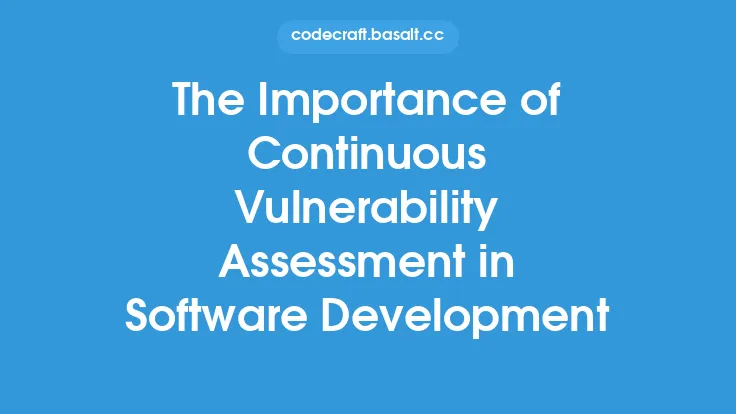The process of software development is inherently complex and fraught with potential risks that can impact the quality, reliability, and security of the final product. As such, it is essential for software developers to employ effective risk assessment methodologies to identify, analyze, and mitigate potential risks throughout the development lifecycle. In this article, we will delve into the various risk assessment methodologies that can be applied to software development, highlighting their strengths, weaknesses, and areas of application.
Introduction to Risk Assessment Methodologies
Risk assessment methodologies are systematic approaches used to identify, analyze, and evaluate potential risks that could impact the software development process. These methodologies provide a structured framework for assessing risks, prioritizing them based on their likelihood and potential impact, and developing strategies to mitigate or manage them. The goal of risk assessment is to minimize the likelihood and impact of adverse events, ensuring that the software development project is completed on time, within budget, and to the required quality standards.
Types of Risk Assessment Methodologies
There are several risk assessment methodologies that can be applied to software development, each with its strengths and weaknesses. Some of the most commonly used methodologies include:
- Failure Mode and Effects Analysis (FMEA): This methodology involves identifying potential failure modes in the software development process, analyzing their effects, and prioritizing them based on their likelihood and potential impact.
- Fault Tree Analysis (FTA): This methodology involves constructing a logical diagram of the potential faults that could occur in the software development process, analyzing their likelihood and potential impact, and identifying strategies to mitigate or manage them.
- Event Tree Analysis (ETA): This methodology involves constructing a logical diagram of the potential events that could occur in the software development process, analyzing their likelihood and potential impact, and identifying strategies to mitigate or manage them.
- Sensitivity Analysis: This methodology involves analyzing how changes in input variables affect the output of the software development process, identifying potential risks and areas of sensitivity.
- Decision Tree Analysis: This methodology involves constructing a logical diagram of the potential decisions that could be made in the software development process, analyzing their likelihood and potential impact, and identifying strategies to mitigate or manage them.
Risk Assessment Process
The risk assessment process involves several steps, including:
- Risk Identification: Identifying potential risks that could impact the software development process, using techniques such as brainstorming, interviews, and review of historical data.
- Risk Analysis: Analyzing the identified risks, using techniques such as probability-impact matrices, to determine their likelihood and potential impact.
- Risk Prioritization: Prioritizing the analyzed risks, based on their likelihood and potential impact, to determine which risks require the most attention and resources.
- Risk Mitigation: Developing and implementing strategies to mitigate or manage the prioritized risks, using techniques such as risk avoidance, risk transfer, and risk reduction.
- Risk Monitoring: Continuously monitoring the risks and their mitigation strategies, to ensure that they are effective and that new risks are identified and addressed in a timely manner.
Benefits of Risk Assessment Methodologies
The use of risk assessment methodologies in software development offers several benefits, including:
- Improved Quality: By identifying and mitigating potential risks, software developers can ensure that the final product meets the required quality standards.
- Reduced Costs: By identifying and mitigating potential risks, software developers can reduce the likelihood of costly rework, delays, and other adverse events.
- Increased Reliability: By identifying and mitigating potential risks, software developers can ensure that the final product is reliable and functions as intended.
- Enhanced Security: By identifying and mitigating potential security risks, software developers can ensure that the final product is secure and protected against potential threats.
Challenges and Limitations
While risk assessment methodologies can be highly effective in identifying and mitigating potential risks, there are several challenges and limitations that software developers should be aware of, including:
- Complexity: Risk assessment methodologies can be complex and time-consuming to apply, requiring significant resources and expertise.
- Uncertainty: Risk assessment methodologies are based on probability and uncertainty, and there is always a risk that potential risks may not be identified or mitigated.
- Limited Resources: Software developers may not have the resources or expertise to apply risk assessment methodologies effectively, limiting their ability to identify and mitigate potential risks.
Best Practices
To ensure that risk assessment methodologies are applied effectively in software development, several best practices should be followed, including:
- Use a Structured Approach: Use a structured approach to risk assessment, such as the risk assessment process outlined above.
- Involve Stakeholders: Involve stakeholders from across the organization in the risk assessment process, to ensure that all potential risks are identified and mitigated.
- Use Multiple Methodologies: Use multiple risk assessment methodologies, to ensure that all potential risks are identified and mitigated.
- Continuously Monitor and Review: Continuously monitor and review the risk assessment process, to ensure that it is effective and that new risks are identified and addressed in a timely manner.
Conclusion
Risk assessment methodologies are essential tools for software developers, providing a systematic approach to identifying, analyzing, and mitigating potential risks throughout the development lifecycle. By understanding the different types of risk assessment methodologies, the risk assessment process, and the benefits and challenges of using these methodologies, software developers can ensure that their products are of high quality, reliable, and secure. By following best practices and using a structured approach to risk assessment, software developers can minimize the likelihood and impact of adverse events, ensuring that their products meet the required standards and are delivered on time and within budget.





